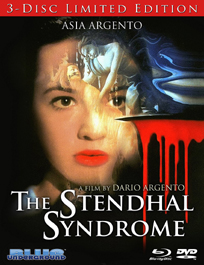 THE
STENDHAL SYNDROME (1996) Limited Edition 3-Disc Blu-ray/DVD combo
THE
STENDHAL SYNDROME (1996) Limited Edition 3-Disc Blu-ray/DVD comboDirector: Dario Argento
Blue Underground
 THE
STENDHAL SYNDROME (1996) Limited Edition 3-Disc Blu-ray/DVD combo
THE
STENDHAL SYNDROME (1996) Limited Edition 3-Disc Blu-ray/DVD comboDario Argento's polarizing giallo THE STENDHAL SYNDROME comes back to Blu-ray in a three-disc special edition from Blue Underground.

Given a tipoff as to the whereabouts of a serial rapist killer, young policewoman Anna Manni (Asia Argento, THE CHURCH) travels from Rome to Florence and visits the Uffizi Museum where she is emotionally and physically overcome by the great power of the artwork and suffers a fugue in which she has no memory of her identity or purpose in the city. Helped back to her hotel by handsome stranger Alfredo (Thomas Kretschmann, KING KONG), she recovers her memory too late to realize that Alfredo is the man she has been hunting. He rapes her and forces her to witness his rape and murder of another victim (Sonia Topazio, WAX MASK) but she is able to escape. Traumatized, Anna returns to Rome, bewildering her colleague and boyfriend Marco (Marco Leonardi, CINEMA PARADISO) as she tries to cope with her experience by cutting her hair and become more aggressive (i.e. male) while attempting to hunt down Alfredo. After meeting with the police psychologist Dr. Cavanna (Paolo Bonacelli, SALO), Anna takes leave and returns to her home town of Viterbo where she recalls having a similar attack as a child when visiting the local Etruscan museum, but Alfredo has been stalking her and captures her again. After enduring more rapes, beatings, and mutilation, Anna turns the tables and mortally wounds Alfredo, dumping him into the nearby aqueduct while still alive. Returning to Rome, she undergoes another personality transformation, donning a blonde wing and becoming more feminine. She begins a romance with art student Marie Beyle (Julien Lambroschini), but Alfredo starts tormenting her by phone and she is sure that he is still alive and stalking her, threatening anyone who gets close to her.
 At
once a return to form and an extreme departure after Argento's attempt that
the American mainstream with the Pittsburgh-lensed Poe anthology TWO EVIL EYES
and the Minnesota-lensed TRAUMA, THE STENDHAL SYNDROME was inspired by a non-fictional
book by psychiatrist Graziella Magherini who had worked in a hospital in Florence
and observed psychosomatic reactions in tourists to the city's works of art
(the title derives from a passage by French author Stendhal about similar symptoms
when encountering the basilica of Santa Croce). It was initially intended as
another American project set in Phoenix, Arizona with Bridget Fonda in the lead
(she had expressed her love of SUSPIRIA to cinematographer Luciano Tovoli while
working on SINGLE WHITE FEMALE) but clashes with American producers and Fonda's
million dollar fee quashed the production which he instead mounted in Italy
with daughter Asia in the lead. The film is rather neatly divided into halves
between Anna's physical victimization by Alfredo and his psychological torment
as Anna first denies and then tries to recover her lost femininity (going from
short-haired androgyny to a double for Veronica Lake). The twist is so obvious
that one wonders if Argento is intending another twist on top of it; and yet,
the film remains affecting for its refusal to titillate its scenes of rape and
violence, focusing instead on Anna's inner devastation and her attempts to deal
with it, from her seeming inability to identify with Alfredo's other surviving
victims (appearing to see them as weak) to her seeming to adapt Alfredo's blood
fetish, and her subsequent attempts to reinvent herself from the inside out
by experimenting with painting and the malleability of her identity (she lets
Marie believe that she is a law student). Argento's performance is effective
and affecting, particularly at the end as she seems to relive her trauma as
her sympathetic colleagues attempt to subdue her, leading to a remarkably tender
closing shot. The photography of the great Giuseppe Rotunno (FELLINI SATYRICON)
eschews the more stylistic flourishes of Argento's past films in favor of very
decisive pans, zooms, and occasional Steadicam shots while his Rembrandt-like
warm-toned lighting and noirish shadows give the film a timeless look that seems
more in keeping with Argento's early quartet of gialli rather than the candy-colored
universe of his horror films. The orchestral score of Ennio Morricone once again
is driven by a lullaby with more melodic strings rather than the dissonant jazz
of BIRD WITH THE CRYSTAL PLUMAGE and CAT O'NINE TAILS or the rock of FOUR FLIES
ON GREY VELVET. The film was one of the first Italian productions to make use
of CGI imagery and the efforts of make-up effects and animatronics artist turned
visual effects supervisor Sergio Stivaletti (DEMONS) are a bit ropey but forgivable
and even suited to the surrealistic nature of their employment. Luigi Diberti
(IMMORTAL BELOVED) appears as Anna's concerned superior while the cast also
includes brief appearances by Cinzea Monreale (BEYOND THE DARKNESS) as Alfredo's
wife, her THE BEYOND co-star Veronica Lazar (INFERNO) in the Italian version
only as Marie's mother, and Vera Gemma (daughter of TENEBRAE's Giuliano Gemma)
as a police officer.
At
once a return to form and an extreme departure after Argento's attempt that
the American mainstream with the Pittsburgh-lensed Poe anthology TWO EVIL EYES
and the Minnesota-lensed TRAUMA, THE STENDHAL SYNDROME was inspired by a non-fictional
book by psychiatrist Graziella Magherini who had worked in a hospital in Florence
and observed psychosomatic reactions in tourists to the city's works of art
(the title derives from a passage by French author Stendhal about similar symptoms
when encountering the basilica of Santa Croce). It was initially intended as
another American project set in Phoenix, Arizona with Bridget Fonda in the lead
(she had expressed her love of SUSPIRIA to cinematographer Luciano Tovoli while
working on SINGLE WHITE FEMALE) but clashes with American producers and Fonda's
million dollar fee quashed the production which he instead mounted in Italy
with daughter Asia in the lead. The film is rather neatly divided into halves
between Anna's physical victimization by Alfredo and his psychological torment
as Anna first denies and then tries to recover her lost femininity (going from
short-haired androgyny to a double for Veronica Lake). The twist is so obvious
that one wonders if Argento is intending another twist on top of it; and yet,
the film remains affecting for its refusal to titillate its scenes of rape and
violence, focusing instead on Anna's inner devastation and her attempts to deal
with it, from her seeming inability to identify with Alfredo's other surviving
victims (appearing to see them as weak) to her seeming to adapt Alfredo's blood
fetish, and her subsequent attempts to reinvent herself from the inside out
by experimenting with painting and the malleability of her identity (she lets
Marie believe that she is a law student). Argento's performance is effective
and affecting, particularly at the end as she seems to relive her trauma as
her sympathetic colleagues attempt to subdue her, leading to a remarkably tender
closing shot. The photography of the great Giuseppe Rotunno (FELLINI SATYRICON)
eschews the more stylistic flourishes of Argento's past films in favor of very
decisive pans, zooms, and occasional Steadicam shots while his Rembrandt-like
warm-toned lighting and noirish shadows give the film a timeless look that seems
more in keeping with Argento's early quartet of gialli rather than the candy-colored
universe of his horror films. The orchestral score of Ennio Morricone once again
is driven by a lullaby with more melodic strings rather than the dissonant jazz
of BIRD WITH THE CRYSTAL PLUMAGE and CAT O'NINE TAILS or the rock of FOUR FLIES
ON GREY VELVET. The film was one of the first Italian productions to make use
of CGI imagery and the efforts of make-up effects and animatronics artist turned
visual effects supervisor Sergio Stivaletti (DEMONS) are a bit ropey but forgivable
and even suited to the surrealistic nature of their employment. Luigi Diberti
(IMMORTAL BELOVED) appears as Anna's concerned superior while the cast also
includes brief appearances by Cinzea Monreale (BEYOND THE DARKNESS) as Alfredo's
wife, her THE BEYOND co-star Veronica Lazar (INFERNO) in the Italian version
only as Marie's mother, and Vera Gemma (daughter of TENEBRAE's Giuliano Gemma)
as a police officer.

THE STENDHAL SYNDROME had a difficult journey to home video stateside for those who could not import the English-dubbed, Japanese-subtitled laserdisc. First picked up by Miramax, the film sat on the shelf until the rights ran out in 1998 whereupon Troma picked the film up with plans for theatrical distribution. Apart from some limited screenings, the film did not become widely available until Troma's VHS release which was derived from a RAI Trade PAL digital master. The company's much-delayed DVD promised commentary by Dario Argento and additional extras. The final disc featured a non-anamorphic 1.53:1 letterboxed transfer from the same master, but there was no commentary and what few extras it had were buried amidst the glut of Troma-related featurettes. Medusa Home Video in Italy remedied this situation in 2003 with a two-disc set presenting new anamorphic transfers of the Italian director's cut – restoring two dialogue scenes not included in the export version – with English subtitles and the English export version with English audio and Italian subtitles; however, the 1.66:1 aspect ratio had been cropped to 1.78:1, the image was subjected to DVNR and the color scheme was skewed away from the warm look of earlier transfers to something cooler and blander. In 2007, Blue Underground did a new high definition master of the Italian cut – with Italian and hybrid English/Italian tracks – in the 1.66:1 aspect ratio for a two-disc set with new interviews. Their subsequent Blu-ray release of the same master made the dreaded scanner noise associated with Italian HD masters prepared by LVR (former film processing company Luciano Vittori) was more apparent.
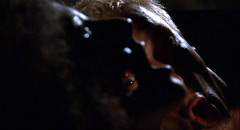 When
Blue Underground announced a new Blu-ray edition earlier this year, there was
much controversy (partially stirred up by this author among others) about the
specifications stated 1.85:1 aspect ratio. The company responded by revealing
that the interpositive material used for the earlier transfers (SD and HD) turned
out to be slightly blown-up with a few hard-matted shots at 1.66:1 while an
examination of the original camera negative revealed that these matted shots
were actually 1.85:1 with additional information on the sides not included on
the IP. No sooner had the disc gone out for review than the 1080p24 MPEG-4 AVC
1.85:1 encode came under scrutiny for its encoding faults which include macro-blocking
most clearly evident in solid blocks of color from museum walls to close-ups
of the characters' clothing, marring what looks like a fine master. Blue Underground
has since arranged an email replacement program for the discs which are set
to be repressed roughly around the start of September. The audio has not been
revisited with the Italian and English tracks – presented in DTS-HD Master
Audio 7.1, Dolby Digital 5.1 EX, and DTS-HD Master Audio 2.0 (a downmix rather
than the original Dolby Stereo Digital mix) – identical to the earlier
Blu-ray/DVD mix (which featured two lossless 7.1 English tracks in DTS-HD Master
Audio and Dolby TrueHD and the Italian track only in Dolby Digital 5.1 EX).
The English dub is still missing a couple lines of dialogue during a conversation
between Anna and Marco as well as a sound effect during one of Alfredo's attacks
on Anna. It is not known if the audio will also be remastered when the disc
is repressed.
When
Blue Underground announced a new Blu-ray edition earlier this year, there was
much controversy (partially stirred up by this author among others) about the
specifications stated 1.85:1 aspect ratio. The company responded by revealing
that the interpositive material used for the earlier transfers (SD and HD) turned
out to be slightly blown-up with a few hard-matted shots at 1.66:1 while an
examination of the original camera negative revealed that these matted shots
were actually 1.85:1 with additional information on the sides not included on
the IP. No sooner had the disc gone out for review than the 1080p24 MPEG-4 AVC
1.85:1 encode came under scrutiny for its encoding faults which include macro-blocking
most clearly evident in solid blocks of color from museum walls to close-ups
of the characters' clothing, marring what looks like a fine master. Blue Underground
has since arranged an email replacement program for the discs which are set
to be repressed roughly around the start of September. The audio has not been
revisited with the Italian and English tracks – presented in DTS-HD Master
Audio 7.1, Dolby Digital 5.1 EX, and DTS-HD Master Audio 2.0 (a downmix rather
than the original Dolby Stereo Digital mix) – identical to the earlier
Blu-ray/DVD mix (which featured two lossless 7.1 English tracks in DTS-HD Master
Audio and Dolby TrueHD and the Italian track only in Dolby Digital 5.1 EX).
The English dub is still missing a couple lines of dialogue during a conversation
between Anna and Marco as well as a sound effect during one of Alfredo's attacks
on Anna. It is not known if the audio will also be remastered when the disc
is repressed.
UPDATE: Blue Underground has not only shipped reauthored replacement Blu-rays to customers but also to reviewers and we have had a chance to look at the new disc and compare it to the old one. The macroblocking is gone and solid surfaces now swim with natural film grain, making the image look that much more inviting in depth (particularly during the Uffizi gallery sequence) and also making the 2K master of the film a great example of what other Italian films, genre or otherwise, of this vintage should look like, particularly those films processed by Cinecitta which were reputed to have looked rather cruddy in cheap theatrical and film market prints and rather bland on their late '90s/early 2000s digital masters (remasters of Argento's SLEEPLESS and THE CARD PLAYER had better look this good). The missing instance of dialogue and some sound effects noted in the first pressing have not been addressed (and to me it does sound like the "thud" of Argento's head hitting the sea floor in her first hallucination sounds more muted than in previous transfers).
 The
Blu-ray and DVD copy feature new extras starting with an audio commentary by
author Troy Howarth who cites THE STENDHAL SYNDROME as Argento's "last
great movie" and discusses it in the context of Argento's failure to break
into Hollywood (revealing that Argento also approached Jennifer Jason Leigh
and Daryl Hannah after Fonda dropped out). He discusses the film's theme of
"the complex relationship between great works of art and the people who
observe them" and the transformation of Anna's character (noting her adopted
blood fetish and how Alfredo's surviving victims seem to have been infected
by his anger) as well as Argento's preference for Jungian psychology even though
his has lent itself to Freudian interpretations (mirroring here Asia's relationship
with her father and his relationship with absent mother). He also notes that
Leonardi replaced the originally cast Stefano Dionisi (FARNELLI) who would later
play the protagonist of SLEEPLESS. He makes the gaffe of stating that no other
film before or since had been allowed to shoot in the Uffizi gallery, but Franco
Zeffirelli would also use the museum interiors for his semi-autobiographical
TEA WITH MUSSOLINI in 1999. In discussing the film's American release history,
he rightly questions why Argento would believe that Troma would give the film
a wide release but does not note that the film had initially been picked up
and shelved by Miramax.
The
Blu-ray and DVD copy feature new extras starting with an audio commentary by
author Troy Howarth who cites THE STENDHAL SYNDROME as Argento's "last
great movie" and discusses it in the context of Argento's failure to break
into Hollywood (revealing that Argento also approached Jennifer Jason Leigh
and Daryl Hannah after Fonda dropped out). He discusses the film's theme of
"the complex relationship between great works of art and the people who
observe them" and the transformation of Anna's character (noting her adopted
blood fetish and how Alfredo's surviving victims seem to have been infected
by his anger) as well as Argento's preference for Jungian psychology even though
his has lent itself to Freudian interpretations (mirroring here Asia's relationship
with her father and his relationship with absent mother). He also notes that
Leonardi replaced the originally cast Stefano Dionisi (FARNELLI) who would later
play the protagonist of SLEEPLESS. He makes the gaffe of stating that no other
film before or since had been allowed to shoot in the Uffizi gallery, but Franco
Zeffirelli would also use the museum interiors for his semi-autobiographical
TEA WITH MUSSOLINI in 1999. In discussing the film's American release history,
he rightly questions why Argento would believe that Troma would give the film
a wide release but does not note that the film had initially been picked up
and shelved by Miramax.
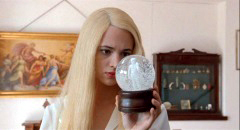 In
“Three Shades of Asia” (20:01), Asia Argento also discusses the
origins of the project, shooting in the Florence heat, creating paintings for
the film, and her displeasure at discovering that she had been dubbed for the
English version when seeing the film at the American Film Market screening.
She states that she did indeed have a body double for the rougher scenes but
that she had become friends with Kretschmann on QUEEN MARGOT and trusted him.
She also states that she has learned a lot from working with her father and
likes the film because the script was primarily his own work (regular collaborator
Franco Ferrini gets story credit with Argento who gets sole screenplay credit).
In “Prisoner of Art” (13:36), Ferrini discusses helping Argento
expand upon Magherini's non-fictional work (Anna was originally a lawyer and
he claims that Kim Basinger was also approached for the project's American iteration
and that Chicago was also considered for a location), the challenge of a police
protagonist when they usually tried to sideline the police in other gialli in
favor of civilian protagonists, and the story structure tips Argento had taken
from working with Sergio Leone. Ferrini is proud of the first twenty minutes
or so of the film but had a somewhat different idea for the ending.
In
“Three Shades of Asia” (20:01), Asia Argento also discusses the
origins of the project, shooting in the Florence heat, creating paintings for
the film, and her displeasure at discovering that she had been dubbed for the
English version when seeing the film at the American Film Market screening.
She states that she did indeed have a body double for the rougher scenes but
that she had become friends with Kretschmann on QUEEN MARGOT and trusted him.
She also states that she has learned a lot from working with her father and
likes the film because the script was primarily his own work (regular collaborator
Franco Ferrini gets story credit with Argento who gets sole screenplay credit).
In “Prisoner of Art” (13:36), Ferrini discusses helping Argento
expand upon Magherini's non-fictional work (Anna was originally a lawyer and
he claims that Kim Basinger was also approached for the project's American iteration
and that Chicago was also considered for a location), the challenge of a police
protagonist when they usually tried to sideline the police in other gialli in
favor of civilian protagonists, and the story structure tips Argento had taken
from working with Sergio Leone. Ferrini is proud of the first twenty minutes
or so of the film but had a somewhat different idea for the ending.
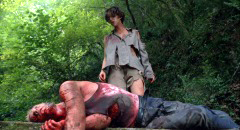
“Sharp as a Razor” (10:03) is an interview with special makeup artist Franco Casagni (BODY PUZZLE) who had previously worked with Rotunno on RED SONJA and the many varieties of fake blood utilized under different lighting conditions and applications (revealing that Argento himself sometimes applied blood to the actors and sets) and mainly focuses on the effects involving Kretschmann. The film's English theatrical trailer (1:03) and a still gallery round out the extras on the Blu-ray and DVD; however, a second DVD includes the extras from the 2007 DVD and 2008 Blu-ray (it is a direct port of the second disc from the DVD set).
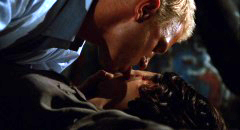 First
up is an interview with director Argento (20:02) who reveals that he read of
the publication of Magherini's book in an Italian paper while in New York to
cast TRAUMA. He discusses his research, including visiting museums in different
cities to study works of Bosch and Rembrandt, as well as recollecting his own
experience as a youth when visiting the Parthenon in Athens. He also discusses
shooting at the Uffizi, and how the production was given permission because
of the museum's admiration for a video that Rotunno had shot for the Prado museum
in Madrid, as well as the ease of working with his daughter apart from the awkwardness
of some of the scenes of brutality. The segment also features some behind the
scenes video, including excerpts from an on-set interview with Asia Argento.
"Inspiration: Psychological Consultant Graziella Magherini" (20:39),
Magherini discusses the circumstances in which she first encountered the phenomena
while working in Florence and covers the symptoms which were treated psychiatrically
and pharmacologically. She then covers her research, including consulting with
art historians and some of the works of art that have provoked the syndrome.
She illustrates the syndrome with not only historical examples but also with
cases that she treated (without revealing the names of the subjects, of course).
First
up is an interview with director Argento (20:02) who reveals that he read of
the publication of Magherini's book in an Italian paper while in New York to
cast TRAUMA. He discusses his research, including visiting museums in different
cities to study works of Bosch and Rembrandt, as well as recollecting his own
experience as a youth when visiting the Parthenon in Athens. He also discusses
shooting at the Uffizi, and how the production was given permission because
of the museum's admiration for a video that Rotunno had shot for the Prado museum
in Madrid, as well as the ease of working with his daughter apart from the awkwardness
of some of the scenes of brutality. The segment also features some behind the
scenes video, including excerpts from an on-set interview with Asia Argento.
"Inspiration: Psychological Consultant Graziella Magherini" (20:39),
Magherini discusses the circumstances in which she first encountered the phenomena
while working in Florence and covers the symptoms which were treated psychiatrically
and pharmacologically. She then covers her research, including consulting with
art historians and some of the works of art that have provoked the syndrome.
She illustrates the syndrome with not only historical examples but also with
cases that she treated (without revealing the names of the subjects, of course).
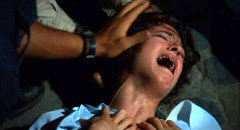 In
"Special Effects" (15:47), Stivaletti starts off discussing his prior
work with Argento starting on PHENOMENA followed by the DEMONS films, the Soavi
films, and OPERA before THE STENDHAL SYNDROME and his proposal to Argento that
they work with digital imagery. Although Stivaletti was not trained in digital
visual effects, he threw himself into it. He also notes clashing with Rotunno
who resisted the merging of video and film, requiring him to recreate shots
Rotunno shot in order to set up the live elements for effects shots. Although
he faced challenges animating the artwork, he faced more familiar ones with
the animatronic fish and shooting the underwater scenes in the open sea rather
than a studio tank. He also reveals that the CGI shot following the pills down
Anna's esophagus was a shot initially proposed for PHENOMENA but they did not
have the technology or the time to achieve it. Although titled "Assistant
Director: Luigi Cozzi" (21:51), Cozzi was the film's second unit director
and he starts off discussing his long partnership with Argento and takes us
through their shared filmography – including discussion of the then-hard-to-see
FOUR FLIES ON GREY VELVET and the TV anthology DOOR INTO DARKNESS, as well as
the less-discussed FIVE DAYS OF MILAN – before focusing on THE STENDHAL
SYNDROME where his prior experience with computer graphics lead to him assisting
on the film and working with Stivaletti. In "Production Designer: Massimo
Antonello Geleng" interview (22:39), Geleng also discusses his prior collaborations
with Argento and the creative rapport they developed as well as his enthusiasm
in working on THE STENDAHL SYNDROME because of his own background in art and
painting. His work extended to recreating live set elements from the paintings
to bridge Stivaletti's illusions, as well as sets including the art studio Marie
works in with its oversized sculptures, Alfredo's aqueduct lair with its graffiti
artwork (some of which was created by graffiti artist she met through his children),
as well as some added paintings for the Uffizi shoot like "The Fall of
Icarus" which figures prominently into the sequence but is indeed not in
the collection. His sketches show a different lighting and color scheme than
Rotunno's, but he also reveals that Rotunno reshaped the lighting scheme of
the Uffizi to better show off the paintings for the camera. Howarth also provides
a fourteen-page booklet. (Eric Cotenas)
In
"Special Effects" (15:47), Stivaletti starts off discussing his prior
work with Argento starting on PHENOMENA followed by the DEMONS films, the Soavi
films, and OPERA before THE STENDHAL SYNDROME and his proposal to Argento that
they work with digital imagery. Although Stivaletti was not trained in digital
visual effects, he threw himself into it. He also notes clashing with Rotunno
who resisted the merging of video and film, requiring him to recreate shots
Rotunno shot in order to set up the live elements for effects shots. Although
he faced challenges animating the artwork, he faced more familiar ones with
the animatronic fish and shooting the underwater scenes in the open sea rather
than a studio tank. He also reveals that the CGI shot following the pills down
Anna's esophagus was a shot initially proposed for PHENOMENA but they did not
have the technology or the time to achieve it. Although titled "Assistant
Director: Luigi Cozzi" (21:51), Cozzi was the film's second unit director
and he starts off discussing his long partnership with Argento and takes us
through their shared filmography – including discussion of the then-hard-to-see
FOUR FLIES ON GREY VELVET and the TV anthology DOOR INTO DARKNESS, as well as
the less-discussed FIVE DAYS OF MILAN – before focusing on THE STENDHAL
SYNDROME where his prior experience with computer graphics lead to him assisting
on the film and working with Stivaletti. In "Production Designer: Massimo
Antonello Geleng" interview (22:39), Geleng also discusses his prior collaborations
with Argento and the creative rapport they developed as well as his enthusiasm
in working on THE STENDAHL SYNDROME because of his own background in art and
painting. His work extended to recreating live set elements from the paintings
to bridge Stivaletti's illusions, as well as sets including the art studio Marie
works in with its oversized sculptures, Alfredo's aqueduct lair with its graffiti
artwork (some of which was created by graffiti artist she met through his children),
as well as some added paintings for the Uffizi shoot like "The Fall of
Icarus" which figures prominently into the sequence but is indeed not in
the collection. His sketches show a different lighting and color scheme than
Rotunno's, but he also reveals that Rotunno reshaped the lighting scheme of
the Uffizi to better show off the paintings for the camera. Howarth also provides
a fourteen-page booklet. (Eric Cotenas)